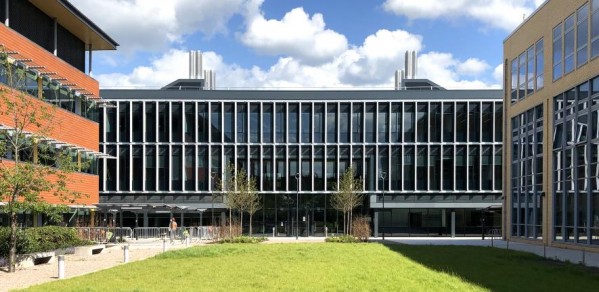
The University’s new Civil Engineering Building provides over 4,000 sqm to house the National Research Facility for Infrastructure Sensing, part of the UK Collaboratorium for Research in Infrastructure & Cities, alongside the Department of Engineering’s Geotechnical and Structures research activities.
Sustainability was central to the design of the building, particularly the use of an Energy Cost Metric, an idea proposed by the late Professor Sir David MacKay
Alexander Reeve, Sustainable Buildings Advisor
Sustainability was central to the design of the building, particularly the use of an Energy Cost Metric, an idea proposed by the late Professor Sir David MacKay (author of 'Sustainable Energy: without the hot air'). The metric helps prioritise measures with the lowest whole life-cycle energy, such as installing a heat pump system which allows the building to use zero fossil natural gas, drawing heat from the ground via boreholes instead. Other measures to minimise impact include the use of a steel frame with pre-cast hollow core floor planks and timber façade supports.
Looking at the building from above, you would be able to see a biodiverse planted roof. Sitting under this is a ‘blue roof’ which can hold up to 120mm of water, delaying water runoff during a storm event and lessening the risk of flooding. Inside, the offices are naturally ventilated with automated dampers and ventilation chimneys to enable night cooling of exposed concrete thermal mass. The building is also designed to facilitate deconstruction and adaptation, for instance connections between floor planks and steel beams can be easily un-bolted, and spaces can be readily converted from natural ventilation to localised mechanical ventilation and vice versa.
In the latest chapter of this building’s story, I’m delighted to announce that these measures have helped it reach the BREEAM Excellent standard. A BREEAM assessment evaluates a building’s design, construction and use, and covers a comprehensive range of topics from energy, water use, ecology and materials, to health and wellbeing. Buildings can achieve a five-point scale of Pass, Good, Very Good, Excellent and Outstanding.
The good news doesn’t stop there though. The designers’ energy predictions suggest the building could use as little as 80kWh/m2/yr but initial readings show even lower consumption levels. This would make it one of the most energy efficient buildings in its class and I’m excited to review its performance in more detail once the distorting effect of the pandemic is over.
Written by Alexander Reeve, Sustainable Buildings Advisor
Image courtesy of Grimshaw Architects

